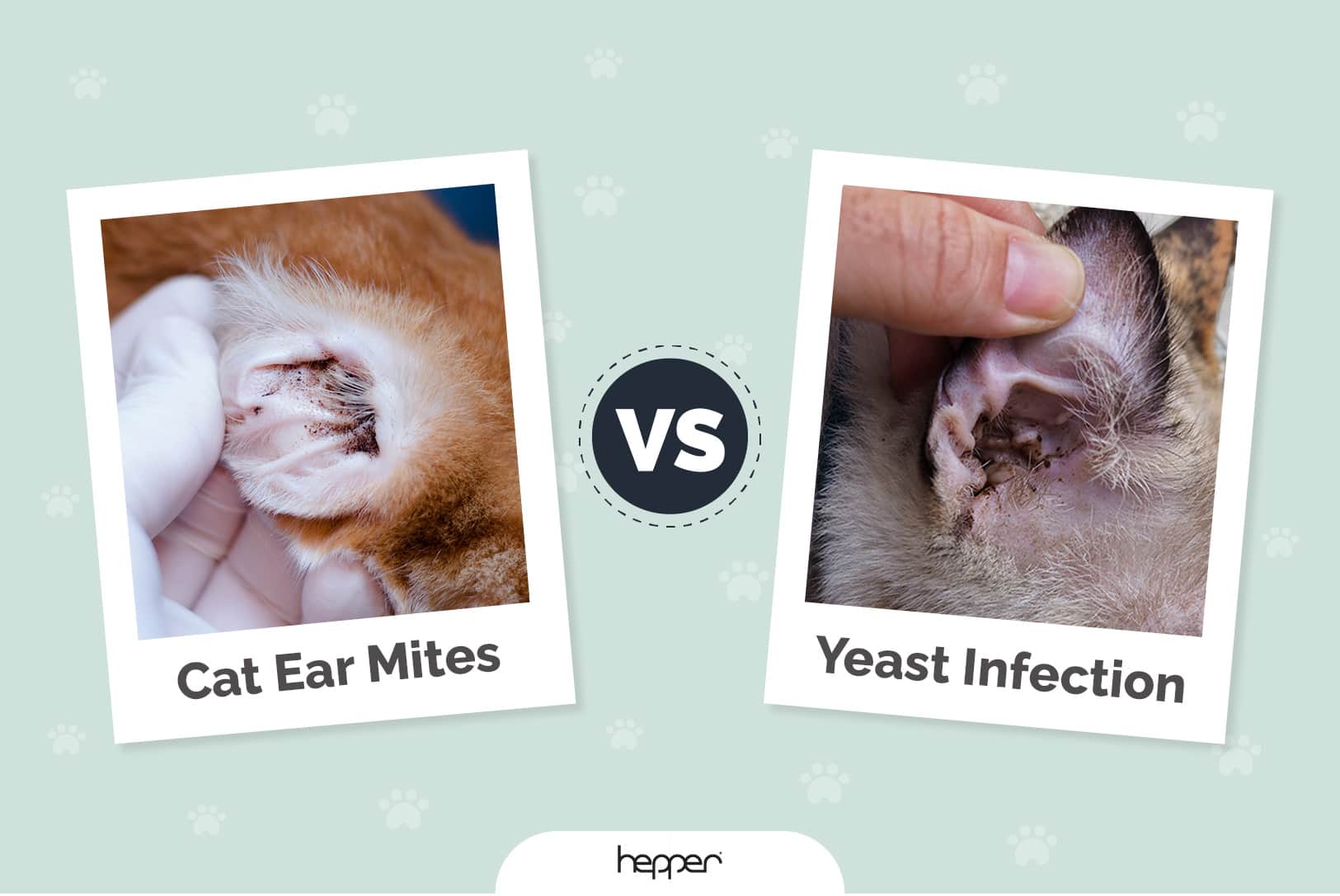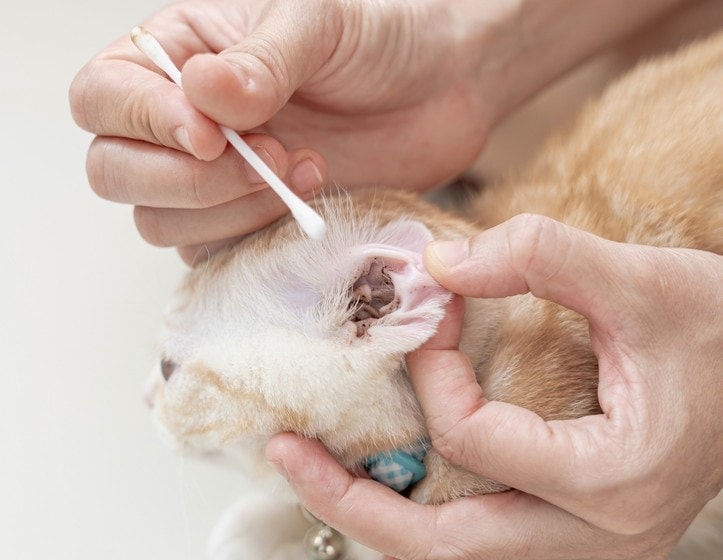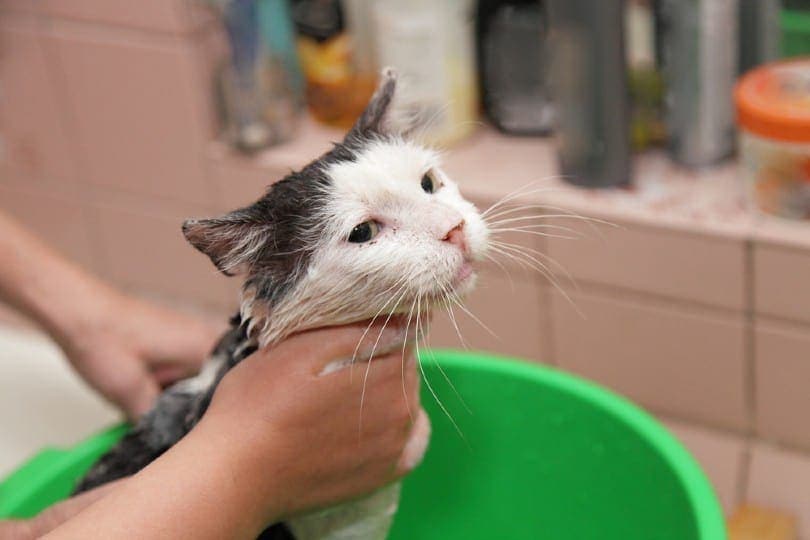Cat Ear Mites vs Yeast Infection: Visual Differences (Vet-Approved)
By Brooke Bundy
Updated on

Click to Skip Ahead
Disclaimer: This article has been approved for medical accuracy by a qualified veterinarian. However, the purpose of this article is not to diagnose your cat or prescribe treatment. Every case is different and cat owners are urged to seek veterinary treatment for the best health outcomes in their pet. Any opinions expressed are those of the writer.
Smelly, irritated ears can indicate that something’s up with your cat. Is it an infection or ear mites? While yeast and bacterial ear infections are relatively common in dogs, they’re not super common in cats—unless they have an underlying issue. If you suspect your cat has an ear infection, they may have ear mites too as this is a common cause of ear infection. This isn’t always the cause, however, especially in older cats or cats with allergies. Let’s look closer into the differences between the two conditions so you can know how to best care for your cat.
Visual Differences

At A Glance
- Evidence looks like tiny specks of dirt or coffee grounds. Mites look like very tiny, white, moving specks.
- Can lead to secondary yeast or bacterial infections.
- Your cat may frequently shake or scratch their head.
- Easily treated by cleaning out the ears and applying veterinary prescribed drops as well as topical flea preventatives that kill mites too.
- Characterized by a sour smell, it usually also leads to dark discharge in the ears.
- May be caused by allergies, ear mites, or a poorly functioning immune system.
- Causes redness and itchiness in your cat’s ears.
- Usually treated by cleaning ears and applying antifungal drops. Underlying cause may require treatment.
Overview of Ear Mites

Virtually all cats can get ear mites. These critters are super contagious, so if one cat in your household has them, it’s usually only a matter of time before they all become infested. They can also move between species. Thankfully, this particular type of mite—officially known as Otodectes cynotis—will only rarely infect humans.1
Ear mites are a common issue in cats, but it isn’t a very serious condition as long as you treat it quickly. If ignored, ear mites can turn into secondary infections such as yeast infections, which can eventually affect your cat’s hearing.
Signs of Ear Mites
The signs of ear mites are fairly easy to spot but they are also caused by any form of ear infection. Cats meticulously groom themselves, so if their outer ear (also called their pinna) looks dirty, they likely have an active infection. Signs of an ear mite infestation include:
- Redness
- Voluntarily shaking head
- Scratching
- Brown or black specks that resemble coffee grounds
- Excessive black or brown looking ear wax
How Are Ear Mites Diagnosed and Treated?
If you take your cat to the vet to treat ear problems, your vet will likely test a swab of debris from inside your cat’s ears. Ear mites are seen easily under the microscope. If you’ve caught the problem fast enough so that no infection has occurred, your cat will probably just need their ears thoroughly cleaned and you’ll be sent home with medication for ear mites. Your vet might also schedule a follow-up appointment with you in a couple of weeks to make sure the infestation is cleared. It can take 3 to 4 weeks to clear an infection due to the life cycle of ear mites.
Overview of Yeast Infection

Yeast infections aren’t common in cats. Thankfully, when they do occur, they most often affect the pinna, or outer ear, and ear canal rather than the middle or inner ear. However, if an infection isn’t dealt with quickly, the infection can spread to the middle or inner ear, which can cause serious hearing loss, although by this time there is usually a plethora of bacteria infecting the ear as well as yeast.
Signs of a Yeast Ear Infection
A yeast infection is characterized by a sour smell, but can present a variety of signs including:
- Redness
- Itchiness
- Excessive scratching or shaking
- Discharge in the ears
- Excessive brown colored wax
If the middle ear becomes infected signs can be a whole lot worse and include: head tilt, hearing loss, facial drooping, abnormal eye movements, loss of balance and stumbling.
How Are Yeast Infections Diagnosed and Treated?
Allergies or an under-performing immune system may cause secondary infections in cats, such as yeast infections. If your vet suspects an allergy, they might suggest medication, switching your cat’s diet or making other lifestyle changes. Ear mites also frequently cause yeast infections, so your cat may need multiple kinds of treatments.
Your vet will take a swab of the debris in your cat’s ears for a cytology test to determine whether the infection is caused by bacteria or a fungus such as yeast. In serious cases, they may even need to assess whether the infection has perforated your cat’s ear drum before proceeding with treatment. Your cat may need to be sedated for this test. Prognosis is usually good, however, and most cats recover their full hearing except for in very severe cases.
For most situations without ear drum perforation, your vet will treat a yeast infection by cleaning the ears and then applying drops that have a mixture of antifungal, antibacterial, and anti-inflammatory medications. You may also be sent home with more ear drops and instructions for keeping your cat’s ears clean.
How Common Are Ear Mites in Cats?
There’s a common misconception that says you’re a dirty person or a bad pet parent if you or your pet develop a parasite infestation. However, that’s definitely not always the case. Rest assured, many cats will have ear mites at some point in their lives, especially if they go outside. It shouldn’t be embarrassing to take your cat to the vet for ear mites. Your veterinarian can assure you that they see them every day and will be eager to provide you with the treatment your cat needs to feel better.
Should I Take My Cat to the Vet for an Ear Problem?
You should take your cat to the vet to properly diagnose and treat any ear problem. Your vet will be able to take a cytology slide to determine the root cause of their ailment and prescribe the exact medicine they need. With your vet’s permission, you can try to clean your cat’s ears at home if you suspect an ear mite infection using an appropriate cleaner that’s specifically formulated for cats. However, you’ll still need treatment from your vet to kill the mites and their eggs as well as any bacteria or yeast in the ear.
It’s always best to take your cat to the vet quickly in case they have an infection. Trying to treat an infection at home isn’t recommended because it might’ve spread to their middle or inner ear. Plus, they’ll likely need antibacterial or antifungal drops that only your vet can prescribe.
Conclusion
Ear mites are common problems in cats, especially those that encounter multiple felines in their day to day life. Yeast infections are a little less common and are frequently caused by ear mites. While ear mites aren’t anything to be ashamed of, you should take your cat to the vet as soon as possible to prevent the problem from progressing into an infection, which can result in permanent hearing loss.
Featured Image Credit: (L) Todorean-Gabriel, Shutterstock | (R) RJ22, Shutterstock













